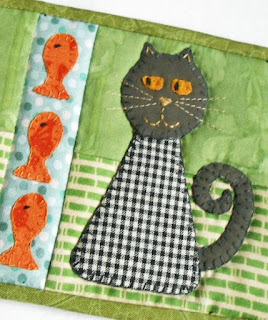 |
| Night Owls Mug Rug |
(Note: To see the stitching close up on any of the mug rugs pictured just click on the mug rug - this will take you through to my Etsy shop where you can scroll over the picture to bring it more into focus.)
What is quick fuse applique? It is a method of fusing fabric to fabric using a fusible webbing. You may know fusible webbing as ‘bondaweb’, ‘wonder under’, ‘steam-a-seam’, ‘Vilene Vleisofix’ - it is all generally the same format - paper with double sided fusible webbing attached. It allows you to fix shapes of fabric onto a background as shown in the Bunny Hop mug rug below.
 |
| Bunny Hop Mug Rug |
Storage of fusible webbing. Some people like to cut sheets of fusible webbing (10"-12” square is a good size) and store the fusible webbing flat, in a bag. Others like to store it on a roll which is how I store mine. Whatever you do you should try not to fold it as this may make the webbing separate from the paper. Whichever method you use it is also a good idea to pop a little silicone sachet (the type that come in handbags or shoes) into the drawer or bag in which it is stored because any moisture in the air can make the webbing separate.
Positioning applique shapes. Take your time when positioning your applique
shapes onto your mug rug prior to fusing.
I always have the applique sheet on the ironing board as I fuse the pieces onto the mug rug - this is how I constructed the Hive on the Side mug rug.
If you do
make a mistake it is sometimes possible to gently pull the webbing shape off and reapply
it but this will depend very much of the fabric used. You will only be able to do this
once though as the webbing will lose its adhesiveness. Also when laying your shapes out on the mug
rug remember to take into account the ¼” border and ensure all shapes are at
least ¼” from all edges of the mug rug (unless the pattern states otherwise). For example, with the Early Bird mug rug below - if you apply the little birds (optional) you will want to position them closer to the tree to allow for the ¼” border on the right-hand side.
 |
| Fun Mug Rug Patterns |
 |
| Early Bird Mug Rug pattern |
Stitching the applique shapes in place. With quick fuse applique the fabric is fused in place so the purpose of your stitching should be to secure the fabric to enable it to be laundered without separating. You can stitch by hand or machine – both give differing looks to the shapes as mentioned previously HERE. The choice is totally up to you. I use both methods – sometimes in the same mug rug as in Moonlit Cat mug rug shown below (the fish bones were hand stitched whilst the cat and moon were machine stitched). I find machine stitching subtle but I also like the rustic look of hand stitching.
 |
| Moonlit Cat Mug Rug |
When
hand stitching the most common stitch used is the blanket stitch but you could
also use a straight stitch, cross stitch or a simple running stitch. The main thing is that you stitch close to
the edge to stop the fabric fraying and to hold it in place. You should be aware however, of the impact the stitching will have on your mug rug.
Tip: When stitching small pieces or felt pieces
use only one strand of cotton rather than the usual two strands. This will
minimise the impact of the stitching. In Black and White Cats I did not want the
stitching on the mouse or the fish to stand out too much so only one strand was
used.
The
size of stitch you use will also impact the overall look. A small stitch appears neat and modern whilst
a larger stitch can appear rustic and country.
In all honesty you most probably have a natural stitch length which will
become evident once you start appliqueing.
 |
| Valentine hearts mug rug pattern |
Finally
the colour of the thread you use can be influential. Nowhere is this more evident than in Valentine Hearts where the gingham heart has contrasting stitching whilst the stitching blends in perfectly on the solid red heart. Many embroidery cottons come in a matt or
sheen look and you will have to decide if you want your stitching to
co-ordinate and blend or contrast and become a stitching feature. Both have their appeal. On the Christmas Delivery mug rug below I have co-ordinated the thread with the robin redbreast but contrasted the thread on the envelope. This has given definition to the envelope whilst the robin needs no such enhancement.
 |
| Christmas Delivery Mug Rug |
Tip: If you do not have access to embroidery
cotton you can get away with using two strands of sewing cotton. This will secure the applique in place and
in many cases you will not be able to tell the difference.
This all sounds like a lot of decision making but once you
start stitching you will find you make these choices naturally and you will discover your quick fuse applique style. Remember that sewing, quilting and embroidery should be fun, productive and satisfying so do not worry if your stitching isn’t always even or the cotton doesn't blend perfectly. Do the best you can, learn along the way and have as much fun as possible.
That's it for this week’s hints and tips.
Next week I will cover the etiquette of participating in a mug rug swap.
Sew until next time ......
Sew until next time ......





















